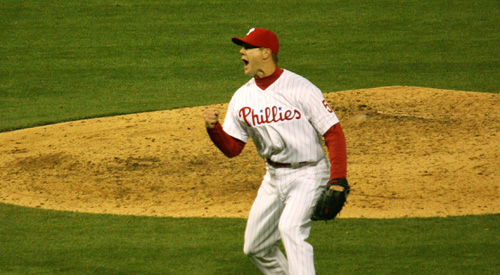
Adding up the value of MLB relief pitching
Vicente Padilla, whom the Red Sox are paying $1.5 million, has put up a Wins Above Replacement (WAR) of 1.1 this season. Jonathan Papelbon accepted a contract from the Phillies worth $60 million over five years (with the fifth year being a vested option), yet his WAR is 1.2. The Phillies are paying an additional $9,500,058 for 0.1 WAR. That’s 1,055,562 cheesesteak sandwiches; enough to give one cheesesteak sandwich to two-thirds of Philadelphia.
Statistically, the best reliever in baseball right now is Aroldis Chapman, who has a 2.9 WAR, and is being paid $2 million. Craig Kimbrel, 2.3 WAR, pockets $590,000. The crooked-cap-wearing Fernando Rodney makes $1.75 million and is the third-best reliever in baseball with 1.8 WAR.
The conclusion? Don’t pay for relievers. Or at least don’t overpay just to beat out another team.
Quality relief pitchers can come from anywhere. Kenley Jansen, the Dodgers’ stud closer, is a converted catcher. Joe Nathan was a shortstop in high school. Sean Doolittle of the A’s is a converted first baseman and has a 1.1 WAR.
Teams love power arms that can come into the game and throw mid 90’s heat at a few guys for two minutes. The benefit to this practice is that you already have the guy under contract (for cheap, too) and if he’s failed at his original position but the coaches have noticed a cannon fixed to his left or right arm, then there’s very little to lose by stranding him onto the mound and seeing what he can do. It’s an inexpensive experiment with very little downside.
[php snippet=1]
The problem with being a reliever is that it only takes one hit against to have blown an assignment. Starting pitchers usually get a few innings of faith to restore any damage they’ve inflicted. For relievers, a few hits and a walk or two at the end of September? Then the reliever’s just blown millions of dollars. The truth, which often seems overlooked, is that that one bad inning is in no way a representation of what the relief pitcher can do going forward. Yet teams remain impatient.
They are focused on finding power arms wherever they can as quickly as they can. So they sometimes miss the quality that’s already available. If teams acknowledge that one bad year doesn’t represent the full value of a reliever and give that pitcher a chance, it can pay off in a big way.
Here’s a selection of relief pitchers that feature in the top 20 of WAR for 2012. See how many you can link to a team immediately (no Googling): Matt Belisle, Tom Wilhelmsen, Vinnie Pestano, Greg Holland, Sean Marshall, David Hernandez, Kelvin Herrera.
Tampa Bay is the champion of this practice. They’ve consistently had an above-average bullpen and refuse to pay the premium of big names relievers. Their entire bullpen in 2012 is worth $11,629,200. That’s $2,129,142 less than Papelbon gets (I’m sorry Pap. I blame the Phillies, not you). Why do teams not follow the example set by the Rays? Why are they not being fiscally responsible when it comes to relief pitchers? Unfortunately it’s probably because they look at the one bad inning their guy had, and they look at the good inning the soon-to-be free agent had, and they decide that because of past performance, their respective future performances will align with what the pitchers have done – not what they’re capable of doing.
The other reason is that teams rarely put an emphasis on investing long-term in relief pitching. The stars of the game are starting pitchers and positional players, so relief pitchers often get overlooked in the drafting and developing process. And then when it comes to the 9th inning, some managers call their bullpens only to have the phone ring out. The managers then text the general managers to ask where their relief pitchers are and the general managers go out and offer $60 million to Papelbon (again, sorry Pap).
Relief pitching is a gamble. Even if you develop them internally, or invest in low-risk, high-reward guys (see: Fernando Rodney) there’s still a high chance it won’t work out. The key difference between investing in the low-risk guys and the high-risk guys is cost. It costs $60 million to take a risk on Papelbon (seriously, I’m so sorry) and only $1.75 million to take a risk on Rodney. It’s the same for developing relief pitching. If draft picks and international signings don’t work out, then the team is not on the hook for too much cash. But if they do work out; if the draft picks and the low-risk free agency signings work out, then a team has the luxury of investing the saved salary in other positions.
[php snippet=1]

